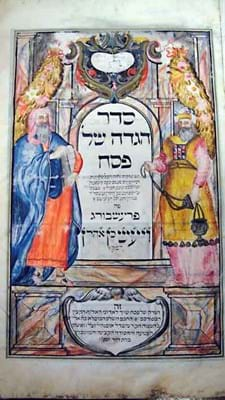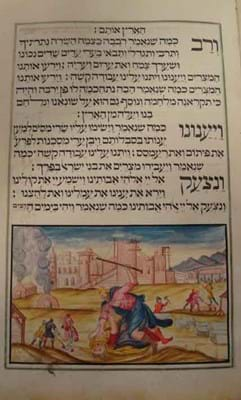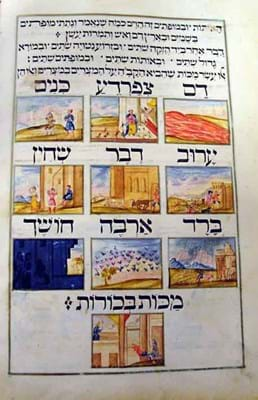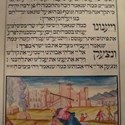Bill Forrest, valuer at the Macclesfield firm, was first shown a box of Jewish prayer books when preparing the Manchester estate of a Rothschild family descendant for sale earlier this year. The 20-leaf vellum manuscript, punctuated by numerous coloured vignettes that set forth the order of the Passover Seder, was found buried towards the bottom but apparently no worse for its recent neglect.
It retained its original boards of red-dyed parchment with remnants of silver tooling (a type of binding typically found on manuscripts of Aaron Wolf Herlingen) and was in fresh condition, save the minor staining on folios whose text relates to the ritual consumption of food.
Research subsequently found that the scribe and artist was Aaron Wolf Herlingen of Gewitsch, Moravia, also known as Aaron Schreiber and a key figure in the renaissance of Hebrew manuscript art that began in Vienna in the early 18th century.
Schooled in the multiple languages of the Holy Roman Empire, in 1736 Herlingen was made scribe of the Imperial Library in Vienna and is known to have completed around 40-50 Haggadot in his career. This particular manuscript was produced during the artist's stay in Pressburg (now Bratislava, Slovakia).
Oppenheimer Connection
Herlingen's signature appears on the architectural title page depicting Aaron and Moses alongside the date 1726 and the name Mendel Oppenheimer - perhaps Emanuel Mendel Oppenheimer (1726-80) - a member of the famous family of Court Jews and descendant of the banker and imperial court diplomat Samuel Oppenheimer (1630-1703).
It is further inscribed in Hebrew This Haggadah belongs to Elijah, son of the deceased Mendel Oppenheimer, and his wife, while a later pencil inscription reads: No.47 Exposition du Albert Hall, an indication that the Haggadah had been an exhibit at the Anglo-Jewish Historical Exhibition held at the Kensington landmark in 1887. At the time, the vendor's family lived in Belgium but moved to London shortly after the Nazi invasion.
Authenticated by Herlingen specialist Prof Emile G.L. Schrijver of the University of Amsterdam, who described it as "100% Wolf, a better than average example", the new discovery made waves in the Judaica collecting world.
Phone Bidding
The Macclesfield saleroom, who gave it a considered £100,000-150,000 estimate as the highlight of their specialist sale of Judaica on November 22, fielded bids from two phones before it sold at £210,000 to a private Austrian Jewish collection.
The price bears comparison with a Haggadah decorated en grisaille by Aaron Wolf Herlingen sold by Boston, Massachusetts, auctioneers Skinner on October 3 for $375,000 (£242,000). Dated 1735, this example, also a recent discovery, was again produced during the artist's stay in Pressburg.
Another Herlingen Haggadah, a larger 33-leaf version, including a map showing the tribulations of the Exodus, made $800,000 (£523,000) at Sotheby's New York in December 2012.
Discounting a fire-figure bid for a Qing vase (a sale that was never completed), the previous house record at Adam Partridge was £86,000 for a pair of Elkington & Co ormolu and cloisonné enamel vases sold in December 2012.
The buyer's premium was 18%.










